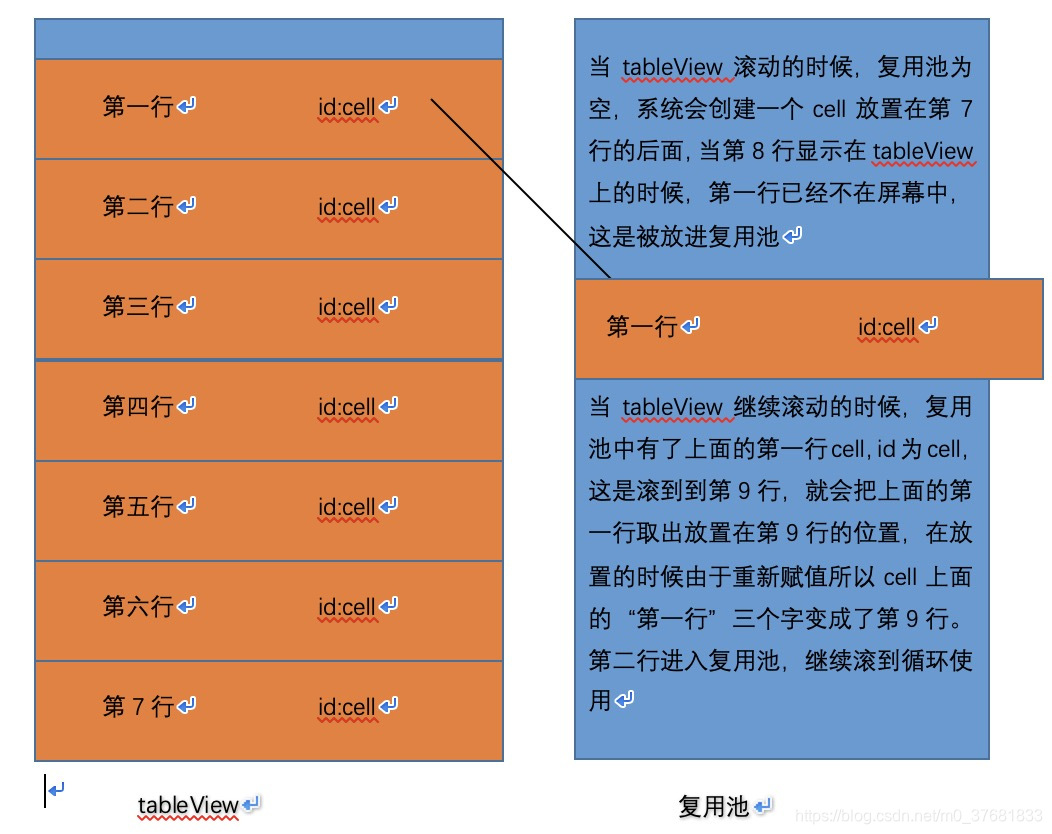在上一篇文章中有下面一段代码:
cell = [[UITableViewCell alloc] initWithStyle:UITableViewCellStyleDefault reuseIdentifier:@"cell"];
这里创建cell的时候设置了一个系统style和一个identifier
这里的两个属性就是今天这篇文章的内容:自定义cell和cell复用。
自定义cell
在通常的开发中,系统默认的cell样式并不能满足设计需求,所以自定义cell样式就是很基本的操作。
下面来简单实现一个和微信通讯录类似的cell:下面是全部代码
CustomerCell.h
#import <UIKit/UIKit.h>
NS_ASSUME_NONNULL_BEGIN
@interface CustomerCell : UITableViewCell
//声明两个属性,用于给视图赋值
@property (nonatomic, copy)NSString *title;
@property (nonatomic, copy)UIImage *image;
@end
NS_ASSUME_NONNULL_END
CustomerCell.m
#import "CustomerCell.h"
@implementation CustomerCell
{
//声明两个视图
UILabel *titleLabel;
UIImageView *iconView;
}
//重写init方法
- (id)initWithStyle:(UITableViewCellStyle)style reuseIdentifier:(NSString *)reuseIdentifier{
//调用父类init方法创建
self = [super initWithStyle:style reuseIdentifier:reuseIdentifier];
if (self) {
//创建成功则t给cell添加需要的子视图
titleLabel = [[UILabel alloc] init];
[self.contentView addSubview:titleLabel];
iconView = [[UIImageView alloc] init];
[self.contentView addSubview:iconView];
}
return self;
}
//重写layoutSubviews方法,给视图设置位置大小
- (void)layoutSubviews{
iconView.frame = CGRectMake(20, 5, 54, 54);
iconView.layer.masksToBounds = YES;
iconView.layer.cornerRadius = 4;
titleLabel.frame = CGRectMake(80, 5, 100, 30);
}
- (void)setTitle:(NSString *)title{
titleLabel.text = title;
}
- (void)setImage:(UIImage *)image{
iconView.image = image;
}
- (void)awakeFromNib {
[super awakeFromNib];
// Initialization code
}
- (void)setSelected:(BOOL)selected animated:(BOOL)animated {
[super setSelected:selected animated:animated];
// Configure the view for the selected state
}
@end
ViewController.m中调用
#import "ViewController.h"
#import "CustomerCell.h"
@interface ViewController ()<UITableViewDelegate, UITableViewDataSource>//添加协议
{
//声明tableView和数据源
UITableView *table;
NSMutableArray *titleArray;
NSMutableArray *imageArray;
}
@end
@implementation ViewController
- (void)viewDidLoad {
[super viewDidLoad];
[self createDataSource];
[self createTableView];
}
//创建数据源
- (void)createDataSource{
//初始化数据源数组
titleArray = [NSMutableArray arrayWithCapacity:0];
imageArray = [NSMutableArray arrayWithCapacity:0];
//循环给数据源中添加元素
for (int i = 0; i < 14; i++) {
NSString *string = [NSString stringWithFormat:@"第%d行", i+1];
[titleArray addObject:string];
NSString *imageName = [NSString stringWithFormat:@"image_%.2d.jpg", i+1];
UIImage *image = [UIImage imageNamed:imageName];
[imageArray addObject:image];
}
//刷新视图
[table reloadData];
}
//创建tableView视图
- (void)createTableView{
//创建并设置位置大小和风格形式
table = [[UITableView alloc] initWithFrame:self.view.bounds style:UITableViewStylePlain];
//设置代理
table.delegate = self;
table.dataSource = self;
//设置纵横滑块不显示
table.showsVerticalScrollIndicator = NO;
table.showsHorizontalScrollIndicator = NO;
[self.view addSubview:table];
}
#define mark --UITableViewDelegate
//设置列表中每个元素的行高,在非动态行高的情况下设置固定值。动态行高的情况需要计算。
- (CGFloat)tableView:(UITableView *)tableView heightForRowAtIndexPath:(NSIndexPath *)indexPath{
return 64;
}
//设置列表中元素的个数 一般设置为数据源中元素的个数
- (NSInteger)tableView:(UITableView *)tableView numberOfRowsInSection:(NSInteger)section{
return titleArray.count;
}
//创建tableView中的每一个cell,这里使用复用机制。
- (UITableViewCell *)tableView:(UITableView *)tableView cellForRowAtIndexPath:(NSIndexPath *)indexPath{
CustomerCell *cell = [tableView dequeueReusableCellWithIdentifier:@"cell"];
if (cell == nil) {
cell = [[CustomerCell alloc] initWithStyle:UITableViewCellStyleDefault reuseIdentifier:@"cell"];
}
cell.title = titleArray[indexPath.row];
cell.image = imageArray[indexPath.row];
return cell;
}
@end
cell复用
//创建tableView中的每一个cell,这里使用复用机制。
- (UITableViewCell *)tableView:(UITableView *)tableView cellForRowAtIndexPath:(NSIndexPath *)indexPath{
CustomerCell *cell = [tableView dequeueReusableCellWithIdentifier:@"cell"];
if (cell == nil) {
cell = [[CustomerCell alloc] initWithStyle:UITableViewCellStyleDefault reuseIdentifier:@"cell"];
}
cell.title = titleArray[indexPath.row];
cell.image = imageArray[indexPath.row];
return cell;
}
在上面的代码的解释是:调用代理方法创建并使用cell,在每次使用cell的时候先从复用池中去找Identifier为“cell”的cell,找到以后就使用,没有就创建一个新的。如下图:

cell的复用机制是复用池的使用,复用池的意思是创建的cell都在池中,每一个cell都有一个Identifier作为标记,在从复用池中取cell的时候会根据Identifier取出,当没有找到的时候才去创建,这样的方式会尽可能少的创建cell以达到优化内存的效果。
复用池的实现是一个字典数组,大致可以理解为:array = [@{@“cell”:cell1, @“Identifier”: @“cell”},@{@“cell”:cell2, @“Identifier”: @“cell”}…];
cell的复用虽然节约了内存,但是有时也会带来一些麻烦,比如在一个带有UITextField的cell上,当cell滚动时,前面输入到textView上的文字会因为复用的问题而消失。这是一个比较严重的问题。在下一篇文章中再去研究带有UITextField的cell如何避免cell复用而带来的问题。























 58
58











 被折叠的 条评论
为什么被折叠?
被折叠的 条评论
为什么被折叠?








